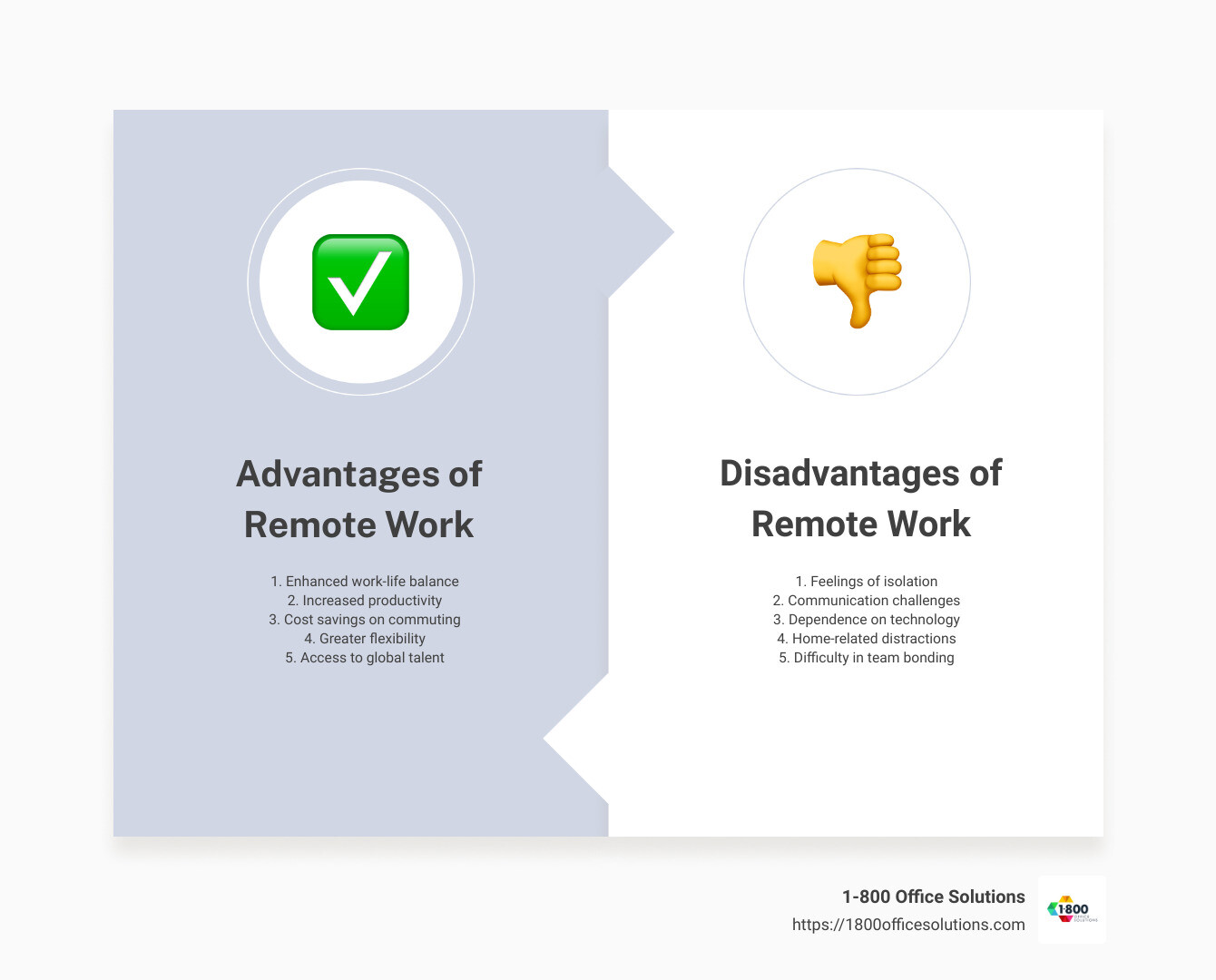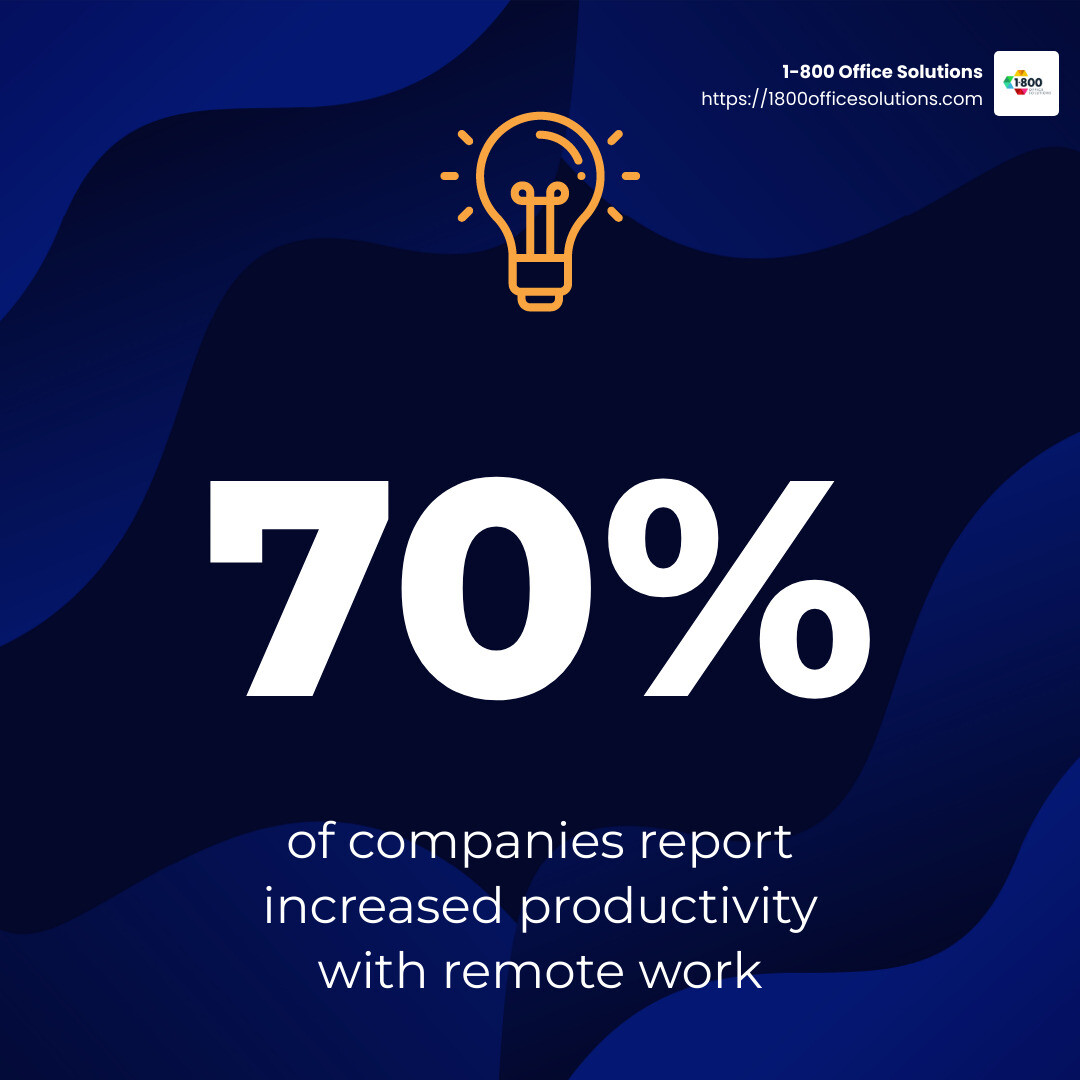An Honest Review of 15 Advantages and Disadvantages of Remote Work
15 advantages and disadvantages of remote work are shaping the future of workplace dynamics. If you’re looking for a quick answer, here’s a breakdown:
- Advantages:
- Improved work-life balance
- Increased productivity
- Cost savings on commuting
- Greater flexibility
- Access to global talent
- Disadvantages:
- Feelings of isolation
- Communication challenges
- Dependence on technology
- Home-related distractions
- Difficulty in team bonding
Remote work has transformed how businesses and employees think about the traditional office. It promises improved work-life balance and heightened productivity, allowing employees to reclaim hours spent commuting and customize their work environments. However, these perks come with challenges like social isolation and reliance on technology.

What is Remote Work?
Remote work means performing your job from anywhere outside the traditional office. This could be your home, a coffee shop, or even a beach in Bali. The key requirement? A reliable internet connection and the necessary tools for your role.
Flexibility
One of the biggest perks of remote work is its flexibility. You can often set your own hours, which means you can start your day early or work late into the night, depending on when you’re most productive. This flexibility allows for a better work-life balance, reducing stress and giving you more time for personal pursuits.
Global Opportunities
Remote work opens doors to global opportunities. You can work for a company headquartered in New York while living in a small town in Italy. This not only broadens your job prospects but also allows companies to tap into a diverse talent pool from around the world.

Bridging Gaps
With remote work, geographical barriers are minimized, allowing people from different parts of the world to collaborate seamlessly. This creates a more inclusive workforce, providing opportunities for those who might face challenges in commuting, such as individuals with disabilities or those living in rural areas.
Remote work is reshaping the landscape of employment, making it more inclusive and adaptable to the needs of modern employees. As we dive deeper into the 15 advantages and disadvantages of remote work, you’ll see how these dynamics play out in real-world scenarios.
15 Advantages and Disadvantages of Remote Work
Advantages of Remote Work
1. Work-Life Balance
Remote work can significantly improve your work-life balance. Without the need for a daily commute, you gain extra time that can be spent on personal activities or with family. This flexibility reduces stress, allowing you to pursue hobbies or simply relax, which contributes to overall well-being.
2. Increased Productivity
Many remote workers find that they are more productive at home. The absence of office distractions like impromptu meetings or noisy colleagues allows for better focus. You can create an environment custom to your productivity needs, whether that means a quiet room or a playlist of your favorite tunes.
3. Cost Savings
Working remotely saves money. You’ll spend less on commuting costs, work attire, and daily lunches. According to a Clever study, the average commuter in the U.S. spends nearly an hour each day traveling, which translates to significant time and financial savings when working from home.
4. Flexibility and Freedom
Remote work offers best flexibility. You can often set your own schedule, working when you feel most productive. This freedom allows you to balance work with personal commitments, like attending a child’s school event or running errands without taking time off.
5. Access to Global Talent
For companies, remote work means access to a global talent pool. Businesses can hire the best candidates regardless of their location, fostering a diverse and inclusive workforce. As Donald Chan from MarTech Wise notes, remote work allows companies to expand their teams with talented individuals worldwide.
Disadvantages of Remote Work
1. Isolation and Loneliness
One downside of remote work is the potential for isolation. Without the daily interactions found in an office, some individuals might feel lonely. This lack of socialization can impact team engagement and overall job satisfaction.
2. Communication Challenges
Remote work can lead to communication challenges. Relying on tools like Slack or Zoom means that conversations are often less spontaneous. This can slow down decision-making and lead to misunderstandings if not managed properly.
3. Technology Dependency
Remote work is heavily dependent on technology. If your internet connection is unstable or your computer malfunctions, it can disrupt your workday. Additionally, not everyone is tech-savvy, which can create problems in adapting to new tools and platforms.
4. Home Distractions
While working from home can boost productivity, it also comes with its own set of distractions. Household chores, family interruptions, or even the temptation to watch TV can pull you away from work tasks. Setting boundaries and creating a dedicated workspace can help mitigate these distractions.
5. Team Bonding and Culture
Maintaining a strong team culture remotely can be challenging. Without face-to-face interactions, building relationships and fostering a sense of belonging requires extra effort. Companies need to be proactive in creating virtual team-building activities to strengthen bonds among remote employees.
As we explore these 15 advantages and disadvantages of remote work, it’s clear that while remote work offers many benefits, it also presents unique challenges that both employees and employers must steer.
Exploring the Advantages of Remote Work
Work-Life Balance
Remote work is a game-changer for work-life balance. With no need to commute, you save valuable time every day. This time can be used for personal activities, reducing stress and allowing you to focus on what truly matters. Whether it’s spending more time with family, pursuing hobbies, or simply relaxing, remote work offers the flexibility to optimize your day.
Increased Productivity
Remote work often leads to increased productivity. Without the distractions of an office environment, like unexpected meetings or chatty coworkers, you can concentrate better on your tasks. The ability to tailor your workspace to your needs—whether it’s a quiet room or a motivating playlist—further improves your focus and efficiency.
Cost Savings
Working remotely can lead to significant cost savings. You eliminate commuting expenses and reduce spending on work attire and lunches. For many, this translates into substantial financial benefits. For example, the average U.S. commuter spends nearly an hour each day traveling, which is time and money saved when working from home.
Flexibility and Freedom
One of the most appealing aspects of remote work is the flexibility and freedom it offers. You can often set your own schedule, allowing you to work during your most productive hours. This flexibility makes it easier to balance work with personal commitments, whether it’s attending a child’s school event or running errands without needing to take time off.
Access to Global Talent
Remote work opens the door to a global talent pool. Companies are no longer limited by geography when hiring, enabling them to find the best candidates from around the world. This not only increases diversity and inclusion within teams but also brings a variety of perspectives and ideas, enhancing creativity and innovation.

As we dig into these advantages, it’s evident that remote work can transform how we live and work, offering benefits that extend beyond the traditional office setup.
Understanding the Disadvantages of Remote Work
Isolation and Loneliness
Remote work can lead to isolation and loneliness. Without the daily interactions that come with working in an office, employees might miss the casual chats and camaraderie that help build team spirit. This lack of socialization can affect team engagement and even lead to feelings of disconnection from the company. According to a YouGov poll, 57% of employees expressed a desire to work from home full-time post-pandemic, yet many still crave the social aspects of office life.
Communication Challenges
Effective communication is crucial in any workplace, but it can be particularly challenging in a remote setup. The reliance on digital tools like Teams and Slack means that communication often has to be more deliberate and planned. This can slow down decision-making processes and make it difficult to convey tone and intent. A strong strategy is needed to ensure clear and consistent communication, which might include regular check-ins and the use of video calls to maintain a sense of connection.
Technology Dependency
Remote work is heavily dependent on technology, which can be a double-edged sword. Employees need reliable internet connections and up-to-date devices to perform their tasks effectively. Issues like slow connections or software glitches can disrupt work and reduce productivity. Furthermore, without immediate access to IT support, remote workers might need to troubleshoot issues themselves, leading to frustration and lost time.
Home Distractions
Working from home comes with its own set of distractions. Household chores, family members, or even the temptation to turn on the TV can interfere with focus and productivity. Creating a dedicated work environment with clear boundaries between personal and professional time is essential. This might mean setting up a specific room or area for work and establishing a routine that signals the start and end of the workday.
Team Bonding and Culture
Building and maintaining a strong corporate culture can be difficult when team members are dispersed. Connection and team bonding often occur through spontaneous interactions and shared experiences that are harder to replicate online. Companies need to find creative ways to foster a sense of belonging and unity among remote workers, such as virtual team-building activities or regular in-person meetups when possible.
By understanding these disadvantages, companies and employees can work together to address the challenges of remote work, ensuring that the benefits are maximized and the drawbacks minimized.
Frequently Asked Questions about Remote Work
What are the biggest benefits of remote work?
Remote work offers several significant benefits that appeal to both employees and employers. One of the most notable is the reduction in carbon footprint. By eliminating daily commutes, remote work can cut down on greenhouse gas emissions significantly. A study found that switching to remote work can reduce up to 58% of a person’s work-related carbon footprint.
Another major advantage is the decrease in operating costs. For employees, this means saving money on commuting, work attire, and daily meals. For companies, remote work can lead to reduced office expenses, such as rent and utilities, as fewer people need to work onsite.
What are the main disadvantages of working from home?
While remote work has its perks, it also comes with challenges. One major downside is the impact on community. Working from home can lead to feelings of isolation and disconnection from coworkers. The lack of in-person interaction can make it difficult to build relationships and a sense of belonging within the company.
Motivation can also be a challenge. Without the structure of an office environment, some people may find it hard to stay motivated and disciplined. The absence of immediate supervision and the presence of home distractions can make it easy to procrastinate.
How can remote work affect productivity?
Remote work can have a mixed impact on productivity. For some, the quiet and comfort of home can improve focus and efficiency. Without office distractions, such as socializing and constant interruptions, remote workers often report getting more done in less time.
However, the lack of a structured office routine can also lead to decreased productivity for others. Home distractions, like household chores or family obligations, can interfere with work. Additionally, the reliance on technology means that any issues with internet connectivity or devices can disrupt workflow.
By addressing these challenges and taking advantage of the benefits, remote work can be a highly effective work model.
Conclusion
As we steer the evolving landscape of work, it’s clear that remote work is more than just a temporary trend—it’s a fundamental shift in how we approach our professional lives. At 1-800 Office Solutions, we understand the complexities and opportunities that come with this change. Our goal is to help businesses adapt and thrive in this new environment by providing the best office solutions.
The hybrid work model, which combines elements of both remote and in-office work, is emerging as a popular choice for many organizations. This model offers the flexibility of remote work while maintaining the benefits of face-to-face interaction. It helps balance the 15 advantages and disadvantages of remote work, such as enhancing work-life balance and productivity, while mitigating challenges like isolation and communication difficulties.
Looking to the future of work, it’s evident that adaptability and innovation will be key. Companies that accept flexible work arrangements are likely to attract top talent and improve employee satisfaction. As we continue to explore new ways of working, it’s important to focus on building a supportive culture that values connection and collaboration, whether employees are working from home or in the office.
At 1-800 Office Solutions, we’re committed to supporting this transition. We offer tools and resources to optimize your work environment, ensuring you can effectively manage a flexible workforce. Find how we can help you create the perfect hybrid office setup.
By embracing these changes and planning strategically, businesses can position themselves for success in the rapidly changing world of work.











